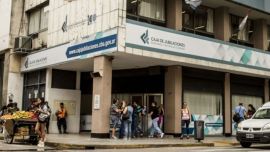Child poverty climbed to 63 percent in 2023, an alarming figure dating back to 2010 levels, a new report by the ODSA Argentine Social Debt Observatory of Universidad Católica Argentina (UCA) has found.
The study, which spans the period 2010 to 2023, highlights the nation’s “structural” problem in line with economic stagnation.
The ODSA-UCA report, entitled ‘Charting the Way: Structural Deprivations, Advances and Challenges in the Right of Children and Teenagers. Argentina 2010-2023,’ reveals alarming figures that detail levels of poverty and destitution among children and teenagers, a sector of the population which has suffered the throes of the unstable economic situation of the country in the last three administrations.
The observatory is a renowned barometer used to assess the evolution of socioeconomic indicators in Argentina, given the unreliable nature of some data produced by the INDEC national statistics bureau during the 2000s and 2010s.
Breaking down data collected up to the second half of 2023, the ODSA-UCA report highlights that 62.9 percent of children and teenagers in Argentina were living in poverty and 16.2 percent were destitute.
'Unjust depreviations'
ODSA defines poverty as “unjust economic deprivations affecting the development of human capacities in different dimensions of social life.”
They are “unjust” since “they affect economic and social rights set forth under the Constitution and international pacts, the report’s authors stress.
As for the latest evaluation which accounted for the increase in child poverty, it was conducted considering the data of the last official census of 2022, the national study shows that there were 7,685,436 children and children and teenagers aged up to 17 years living in poverty, and among them, 1,979,397 destitute.
Unlike other institutions, the ODSA’s research is based on a calculation of multidimensional poverty, which considers not only monetary aspects but five variables of child development: food, sanitation, housing, healthcare and access to information.
This provides a more detailed version of the shortfalls faced by children and teenagers and the impact on their development, the body argues.
The report underlines that as of the close of 2023, 56.3 percent of children and teenagers were living in “multidimensional poverty,” which means that over half the child population was facing at least one deprivation in these fundamental rights.
On the other hand, 16.1 percent of children and teenagers experienced multidimensional poverty at severe levels, an alarming figure which is nearly identical to that of child monetary destitution.
‘Structural challenges’
As for the economic aspects, calculated in terms of the basic food basket, from UCA they indicated that even though social policies have had a “crucial” role to “mitigate poverty”, there are still “structural challenges in the economy which require attention and which have a strong impact on the opportunity structures of households and their child and teenager members.”
The study also compares its finds with the INDEC data, which calculates child poverty in the range up to 14 years, a different methodology from that used by the ODSA.
According to the INDEC, in the second half of 2023, child poverty reached 58.4 percent. The differences between the figures of both studies can be attributed to the different methodologies and age ranges used to measure poverty.
One point in common is the impact of the Covid-19 pandemic in socioeconomic indicators, reflecting an exacerbation of the existing difficulties. The report points out that, although some improvements were observed in 2023, the road towards full recovery is still uncertain. Food insecurity, for example, affects 32.2 percent of children and teenagers, a problem which has remained high since 2018, with a peak of 37.2 percent in 2020 during the lengthy lockdown ordered by former president Alberto Fernández to tackle the spread of coronavirus.
Health and housing
Addressing healthcare, the study reveals 55.8 percent of children and teenagers did not have health insurance, depending exclusively on the state system for medical care. This percentage is especially high among the lowest social groups and single-parent families.
Although improvements were recorded in the access to medical and dentistry consultations, the deficits are still significant, according to the report.
In terms of housing, the report indicates that 39.5 percent of children and teenagers were facing deficits in such basic services as running water and sanitation. In addition, 49.4 percent were living in deteriorated environmental conditions near polluting factories and rubbish dumps.
For education, the report highlights that 23 percent of children aged three to five had no formal schooling. Although there have been advances in early school attendance since 2010, the disparities between different social groups persist at an alarming rate, thus exacerbating the socio-economic gap.
Other outstanding data points show that 82.6 percent of children and teenagers aged six to 17 attend state schools, but educational coverage remains a challenge in underprivileged households.
– TIMES/PERFIL




















Comments